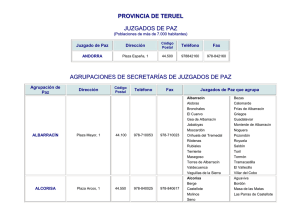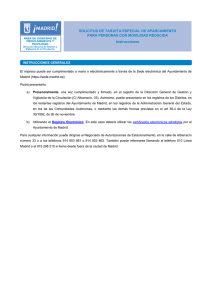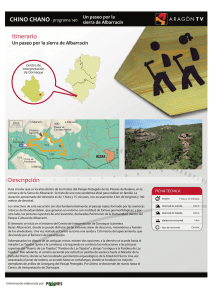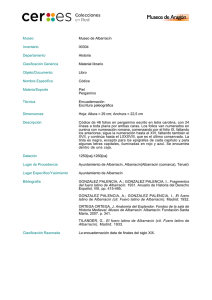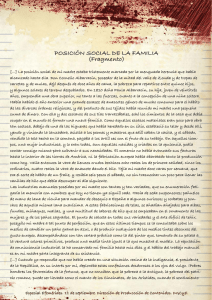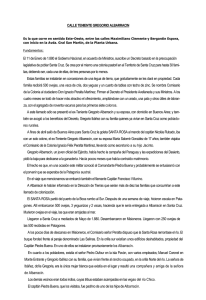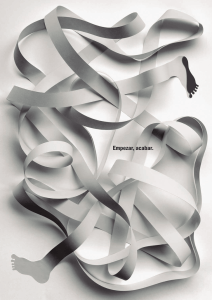Para descargar la hoja de sala pulsar aquí.
Anuncio
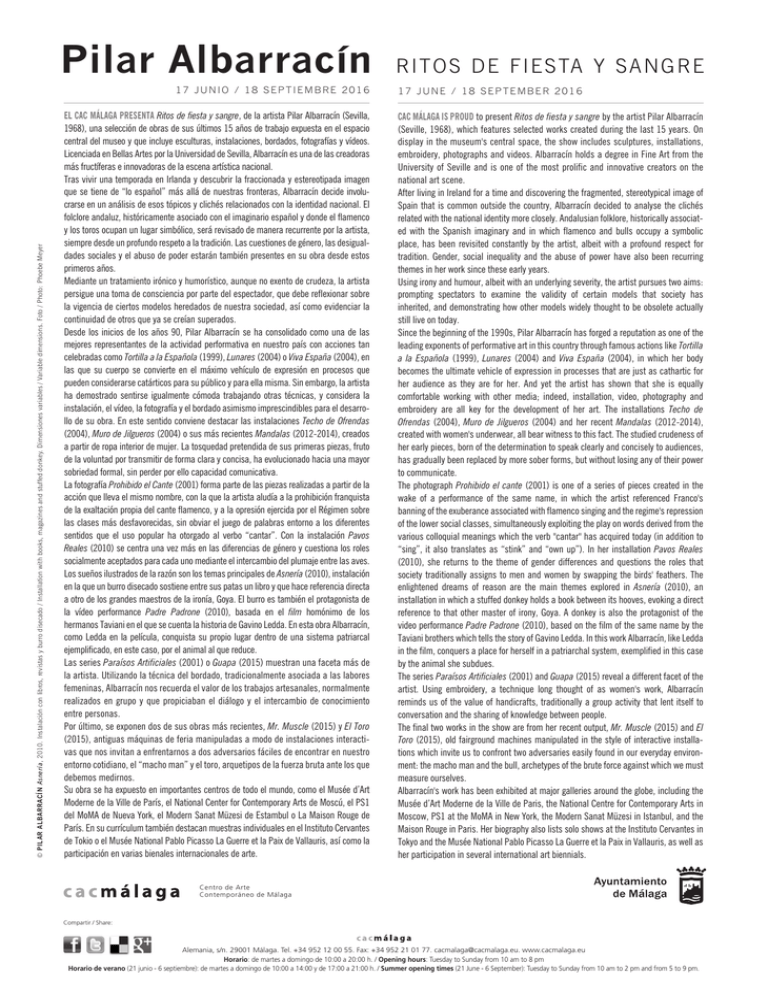
Pilar Albarracín © PILAR ALBARRACÍN Asnería, 2010. Instalación con libros, revistas y burro disecado / Installation with books, magazines and stuffed donkey. Dimensiones variables / Variable dimensions. Foto / Photo: Phoebe Meyer 1 7 J U NIO / 1 8 SE P T I E MB R E 2 0 1 6 EL CAC MÁLAGA PRESENTA Ritos de fiesta y sangre, de la artista Pilar Albarracín (Sevilla, 1968), una selección de obras de sus últimos 15 años de trabajo expuesta en el espacio central del museo y que incluye esculturas, instalaciones, bordados, fotografías y vídeos. Licenciada en Bellas Artes por la Universidad de Sevilla, Albarracín es una de las creadoras más fructíferas e innovadoras de la escena artística nacional. Tras vivir una temporada en Irlanda y descubrir la fraccionada y estereotipada imagen que se tiene de “lo español” más allá de nuestras fronteras, Albarracín decide involucrarse en un análisis de esos tópicos y clichés relacionados con la identidad nacional. El folclore andaluz, históricamente asociado con el imaginario español y donde el flamenco y los toros ocupan un lugar simbólico, será revisado de manera recurrente por la artista, siempre desde un profundo respeto a la tradición. Las cuestiones de género, las desigualdades sociales y el abuso de poder estarán también presentes en su obra desde estos primeros años. Mediante un tratamiento irónico y humorístico, aunque no exento de crudeza, la artista persigue una toma de consciencia por parte del espectador, que debe reflexionar sobre la vigencia de ciertos modelos heredados de nuestra sociedad, así como evidenciar la continuidad de otros que ya se creían superados. Desde los inicios de los años 90, Pilar Albarracín se ha consolidado como una de las mejores representantes de la actividad performativa en nuestro país con acciones tan celebradas como Tortilla a la Española (1999), Lunares (2004) o Viva España (2004), en las que su cuerpo se convierte en el máximo vehículo de expresión en procesos que pueden considerarse catárticos para su público y para ella misma. Sin embargo, la artista ha demostrado sentirse igualmente cómoda trabajando otras técnicas, y considera la instalación, el vídeo, la fotografía y el bordado asimismo imprescindibles para el desarrollo de su obra. En este sentido conviene destacar las instalaciones Techo de Ofrendas (2004), Muro de Jilgueros (2004) o sus más recientes Mandalas (2012-2014), creados a partir de ropa interior de mujer. La tosquedad pretendida de sus primeras piezas, fruto de la voluntad por transmitir de forma clara y concisa, ha evolucionado hacia una mayor sobriedad formal, sin perder por ello capacidad comunicativa. La fotografía Prohibido el Cante (2001) forma parte de las piezas realizadas a partir de la acción que lleva el mismo nombre, con la que la artista aludía a la prohibición franquista de la exaltación propia del cante flamenco, y a la opresión ejercida por el Régimen sobre las clases más desfavorecidas, sin obviar el juego de palabras entorno a los diferentes sentidos que el uso popular ha otorgado al verbo “cantar”. Con la instalación Pavos Reales (2010) se centra una vez más en las diferencias de género y cuestiona los roles socialmente aceptados para cada uno mediante el intercambio del plumaje entre las aves. Los sueños ilustrados de la razón son los temas principales de Asnería (2010), instalación en la que un burro disecado sostiene entre sus patas un libro y que hace referencia directa a otro de los grandes maestros de la ironía, Goya. El burro es también el protagonista de la vídeo performance Padre Padrone (2010), basada en el film homónimo de los hermanos Taviani en el que se cuenta la historia de Gavino Ledda. En esta obra Albarracín, como Ledda en la película, conquista su propio lugar dentro de una sistema patriarcal ejemplificado, en este caso, por el animal al que reduce. Las series Paraísos Artificiales (2001) o Guapa (2015) muestran una faceta más de la artista. Utilizando la técnica del bordado, tradicionalmente asociada a las labores femeninas, Albarracín nos recuerda el valor de los trabajos artesanales, normalmente realizados en grupo y que propiciaban el diálogo y el intercambio de conocimiento entre personas. Por último, se exponen dos de sus obras más recientes, Mr. Muscle (2015) y El Toro (2015), antiguas máquinas de feria manipuladas a modo de instalaciones interactivas que nos invitan a enfrentarnos a dos adversarios fáciles de encontrar en nuestro entorno cotidiano, el “macho man” y el toro, arquetipos de la fuerza bruta ante los que debemos medirnos. Su obra se ha expuesto en importantes centros de todo el mundo, como el Musée d’Art Moderne de la Ville de París, el National Center for Contemporary Arts de Moscú, el PS1 del MoMA de Nueva York, el Modern Sanat Müzesi de Estambul o La Maison Rouge de París. En su currículum también destacan muestras individuales en el Instituto Cervantes de Tokio o el Musée National Pablo Picasso La Guerre et la Paix de Vallauris, así como la participación en varias bienales internacionales de arte. RITOS DE FIESTA Y SANGRE 17 JUNE / 18 SEPTEMBER 2016 CAC MÁLAGA IS PROUD to present Ritos de fiesta y sangre by the artist Pilar Albarracín (Seville, 1968), which features selected works created during the last 15 years. On display in the museum's central space, the show includes sculptures, installations, embroidery, photographs and videos. Albarracín holds a degree in Fine Art from the University of Seville and is one of the most prolific and innovative creators on the national art scene. After living in Ireland for a time and discovering the fragmented, stereotypical image of Spain that is common outside the country, Albarracín decided to analyse the clichés related with the national identity more closely. Andalusian folklore, historically associated with the Spanish imaginary and in which flamenco and bulls occupy a symbolic place, has been revisited constantly by the artist, albeit with a profound respect for tradition. Gender, social inequality and the abuse of power have also been recurring themes in her work since these early years. Using irony and humour, albeit with an underlying severity, the artist pursues two aims: prompting spectators to examine the validity of certain models that society has inherited, and demonstrating how other models widely thought to be obsolete actually still live on today. Since the beginning of the 1990s, Pilar Albarracín has forged a reputation as one of the leading exponents of performative art in this country through famous actions like Tortilla a la Española (1999), Lunares (2004) and Viva España (2004), in which her body becomes the ultimate vehicle of expression in processes that are just as cathartic for her audience as they are for her. And yet the artist has shown that she is equally comfortable working with other media; indeed, installation, video, photography and embroidery are all key for the development of her art. The installations Techo de Ofrendas (2004), Muro de Jilgueros (2004) and her recent Mandalas (2012-2014), created with women's underwear, all bear witness to this fact. The studied crudeness of her early pieces, born of the determination to speak clearly and concisely to audiences, has gradually been replaced by more sober forms, but without losing any of their power to communicate. The photograph Prohibido el cante (2001) is one of a series of pieces created in the wake of a performance of the same name, in which the artist referenced Franco's banning of the exuberance associated with flamenco singing and the regime's repression of the lower social classes, simultaneously exploiting the play on words derived from the various colloquial meanings which the verb "cantar" has acquired today (in addition to “sing”, it also translates as “stink” and “own up”). In her installation Pavos Reales (2010), she returns to the theme of gender differences and questions the roles that society traditionally assigns to men and women by swapping the birds' feathers. The enlightened dreams of reason are the main themes explored in Asnería (2010), an installation in which a stuffed donkey holds a book between its hooves, evoking a direct reference to that other master of irony, Goya. A donkey is also the protagonist of the video performance Padre Padrone (2010), based on the film of the same name by the Taviani brothers which tells the story of Gavino Ledda. In this work Albarracín, like Ledda in the film, conquers a place for herself in a patriarchal system, exemplified in this case by the animal she subdues. The series Paraísos Artificiales (2001) and Guapa (2015) reveal a different facet of the artist. Using embroidery, a technique long thought of as women's work, Albarracín reminds us of the value of handicrafts, traditionally a group activity that lent itself to conversation and the sharing of knowledge between people. The final two works in the show are from her recent output, Mr. Muscle (2015) and El Toro (2015), old fairground machines manipulated in the style of interactive installations which invite us to confront two adversaries easily found in our everyday environment: the macho man and the bull, archetypes of the brute force against which we must measure ourselves. Albarracín's work has been exhibited at major galleries around the globe, including the Musée d’Art Moderne de la Ville de Paris, the National Centre for Contemporary Arts in Moscow, PS1 at the MoMA in New York, the Modern Sanat Müzesi in Istanbul, and the Maison Rouge in Paris. Her biography also lists solo shows at the Instituto Cervantes in Tokyo and the Musée National Pablo Picasso La Guerre et la Paix in Vallauris, as well as her participation in several international art biennials. Centro de Arte Contemporáneo de Málaga Compartir / Share: Alemania, s/n. 29001 Málaga. Tel. +34 952 12 00 55. Fax: +34 952 21 01 77. [email protected]. www.cacmalaga.eu Horario: de martes a domingo de 10:00 a 20:00 h. / Opening hours: Tuesday to Sunday from 10 am to 8 pm Horario de verano (21 junio - 6 septiembre): de martes a domingo de 10:00 a 14:00 y de 17:00 a 21:00 h. / Summer opening times (21 June - 6 September): Tuesday to Sunday from 10 am to 2 pm and from 5 to 9 pm.
